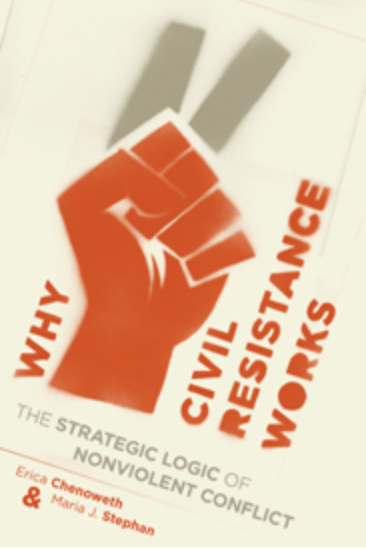The Nazi Thermometer
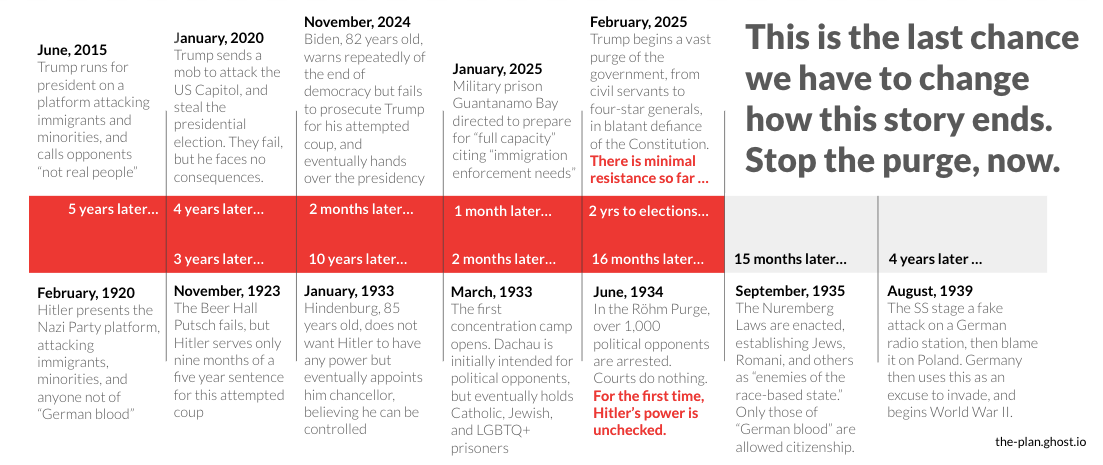
Welcome to the first Thursday installment! Thursdays are for things that can't wait. If we're talking about things that are important in the long term, like developments in social psychology during the post-war years, that will go on a Tuesday. If we're talking about things that are more important in the short term, like ways to combat the still-ongoing purge of the American system, that's going to go on a Thursday. Like today.
Because it's the first one – and because of who I am, deep down in my soul – I'm going to start with some conceptual setup.
The Challenges of Pacing
In simultaneously talking about the long-term problems, and reacting to the short-term ones, there is an unavoidable challenge - let's call it narrative coherence. The Plan, a 300-page document given years of thought and effort, proceeds in a logical, stepwise fashion. Setup, Action, Reaction, Resolution. It is also told like a story, and no good storyteller wants to ruin the ending. But few storytellers in history have been confronted by the de facto leader of the free world proudly brandishing a chainsaw at a live audience as a metaphor for what they are doing to the American government.

While I am complaining, I will also mention that this is difficult in other ways. Long and fast are usually separate specialities. Perhaps the most visually striking example of this is in two of the fastest men in the world. Usain Bolt, who holds the now 15-year old record as the fastest 100m sprinter in history, was 6'5'' and 208 lbs when he did it. Eliud Kipchoge, the first man in history to run a marathon in under two hours, was 5'7'', 114 lbs.

Perhaps the real moral is that Kipchoge was still running 17.08s hundreds – 422 times. That's 4:35 mile pace, for 26 miles. Fast is fast. But what does this all mean, exactly? All I am saying is that I will do the best I can, and if when next you see me one of my arms is dramatically larger than the other, this will be the reason.
No, sorry – what I am saying is that I hope you will forgive me if I am forced to introduce ideas several times – both when they make sense, and when they are needed. One of these ideas is:
The Curriculum
One idea I will continue to hammer on is that, even if short-term actions are unambiguously critical, they are also the ones most likely to have already captured the public's attention - while the long-term ones remain unaddressed. For example, even if we were able to return every purged federal employee to their jobs – and we have to try (more on this below) – we would still be in a country where only 3 in 10 Americans understand that we have to cut carbon emissions completely, in order to avoid (what may already be unavoidable) permanent changes to the basic habitability of the planet.

Anyone who works in messaging, or advertising, or education, or advocacy, will say that changing that number is a massive task – and if you talked to any political strategist, they would say that changing all of those minds is not necessary for winning elections. And they would all be right! They are experts after all, even if they're imaginary. I'm not arguing with that. But it's not what I'm thinking about.
I'm thinking about the distribution of information that is necessary for a safe, stable, functioning, country. Because even if we win back a trifecta, and stop the ongoing purge, and even get our climate policies back on track; if an enormous group of Americans literally do not believe that a problem we are solving, exists – then someone will exploit their rage in a way that will fundamentally threaten our progress, again. And I, at least on Tuesdays, am thinking on that timescale.
The problem is, thinking back to my imaginary chorus of experts, the effort needed to educate hundreds of millions of people, deeply, and on a wide range of important subjects, is on the same magnitude as the Allied occupation of Berlin. (And a job for the Department of Education, which is why it's a target for total destruction.)
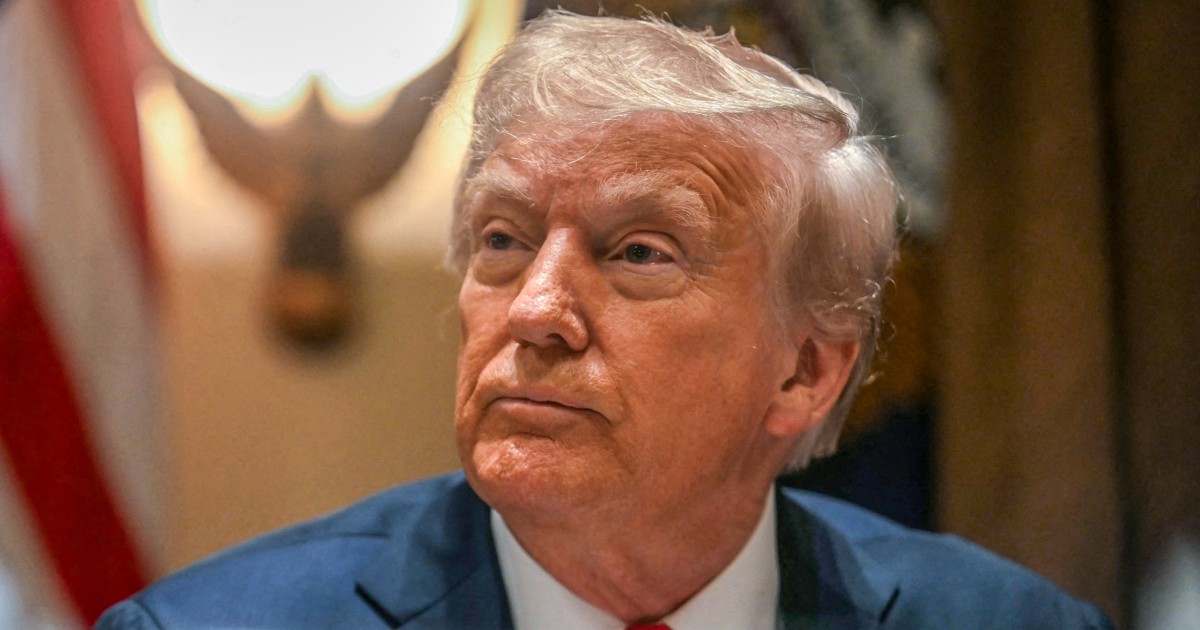
So from a practical standpoint, the question becomes:
What is the smallest, lightest-weight, easiest to transmit, set of materials – that will be most persuasive, to the largest relevant population – and that addresses the issues most central to a stable and functioning society? I refer to this collection of materials, real and not yet real, as The Curriculum. And I will come back to it, as well as what I think should be part of it, and why – when it makes sense in the larger picture.
But right now, on this first Thursday installment, I am very proud to share the first shot at the first piece of a very large problem – and, a piece of work that had a much deeper effect on me than I expected.
(Important note! This was made with a collaborator, to whom I am already deeply indebted. For personal reasons, this collaborator has asked to remain anonymous, but they have been a key contributor already – and if you are interested in joining them, anonymously or not, by all means get in touch.)
Now – allow me to introduce The Nazi Thermometer.
The Thermometer, or perhaps The Timeline
There have been many, many comparisons of Donald Trump and Adolf Hitler, some academic, some casual, some persuasive, and others not. But as I walked past the steel barricades that followed me practically the two full miles from my house to my office, something in my subconscious began to assemble the many, many similarities of which I have been made aware one by one.
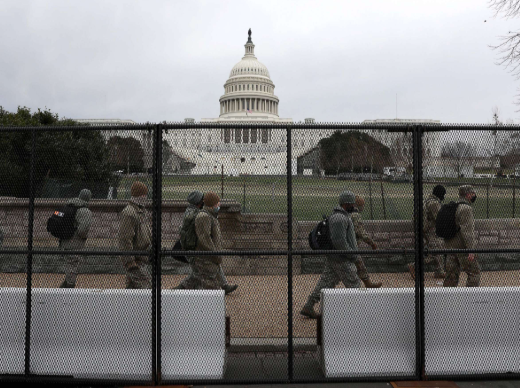
Because these similarities made a line – and I wanted to show where that line was pointing. I didn't focus-group it, I didn't workshop it, I didn't field-test it – I just decided to put together the information that I felt most emotionally compelled to compile. It looks like this:
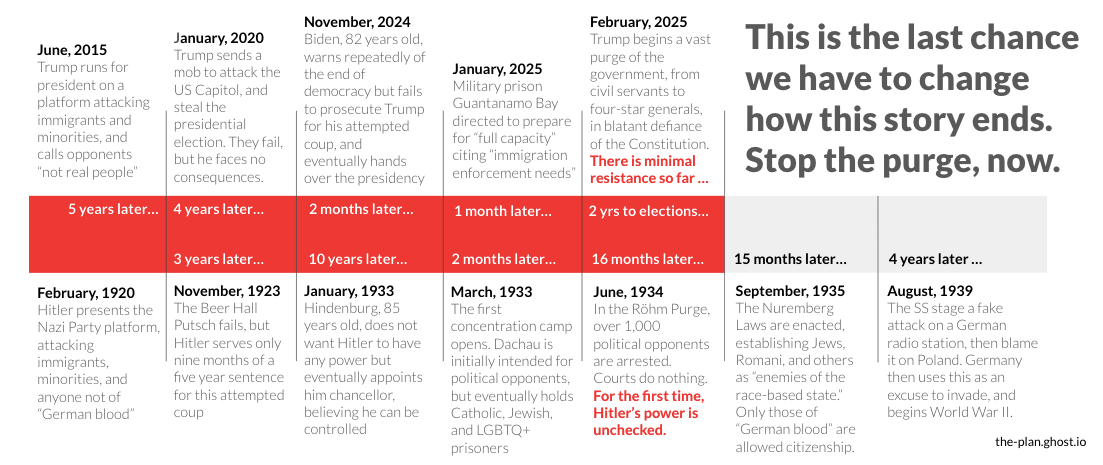
I thought it was going to be fairly self-explanatory. I thought it was going to be a straight-forward search on Wikipedia for a few key dates, a little image tweaking, and it would be ready. I thought I knew the story, knew the comparison, knew the stakes.
It simply had not struck me, how pivotal a moment we are in – right now.
At this point, we've all seen some shit, we've all been through some shit. I took the Oath of Office on January 7th, 2021, Elon Musk destroyed my federal career, I had to live next to Matt Gaetz and his hardtop white Porsche with the smashed in front fender for a whole year (though I still like to think he moved out because of me) – it's been a time. But as I looked at the timeline that I myself had created, using dates and events and people about whom I myself had known, it was only then that I saw a simple fact, with a frightening clarity. Everything we've seen of Donald Trump – has been with the reins on. And the Hitler that the world remembers is the Hitler who was operating with the reins off. Which was only possible – after the purge of the government – that is happening now. In other words:
Things look bad. But if you look at the timeline, this isn't bad.
This is in preparation for things to get bad.
Bad enough that the United States Armed Forces would try to stop it.
Am I impossibly stupid, slow, short-sighted, naive or over-optimistic to have missed this? Have I ignored it when other people said it? Did I actually know this, but it just hadn't "clicked" yet? I don't know. These could all be true – I feel all of them. But if I, after a lifetime of politics and scholarship and reading and protesting could see something new in all this then, well, I'm hoping you might too.
A Detour for a Good Book with a Dumb Title
You might argue - by which I mean of course, I see an opening in this argument – that what's happening right now can't quite be the Night of the Long Knives because nobody (much, yet) is getting arrested, and nobody (???) is getting killed. So the analogy just isn't appropriate. But I would respond with a book published by Princeton University Press, written by political scientist Daniel Treisman and economist Sergei Guriev: Spin Dictators.
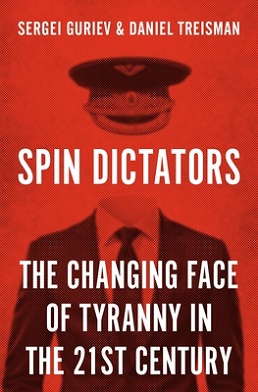
The argument is that in the middle of the 20th century, tyrants like Hitler, Mao, and Stalin killed people in vast numbers – and these examples, understandably, came to define what we think of as dictators. However just a few decades later, unambiguous dictators like Lee Kuan Yew in Singapore and Alberto Fujimori in Peru, then later Erdogan in Turkey and Orbán in Hungary, realized that they didn't need to kill (as many) people. In fact, the opposition it provoked often made their job (stealing) harder.
So they started doing things in a more – "modern" – way. Pretending to be democratic. Allowing inconsequential elections. Purchasing newspapers, instead of raiding them. Giving people jobs, instead of just bags of cash. Or instead of kicking in the doors to their houses, just telling them –
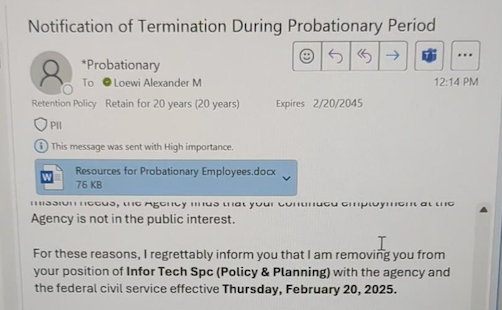
"Your continued employment at the Agency is not in the public interest."
This happened one week ago. This is still happening. This is happening to the government.
If you kill one of Jack Smith's lawyers – the gloves come off. But if you simply void the security clearances of Jack Smith's lawyers – you've also kept them from working on cases that involves high-clearance materials, like investigating the sitting President for treason, for much less fuss.

The point is, if everybody leaves without a fuss, then – they're still gone. And the people who removed them can do whatever they want. Which, if it just involves theft, bad taste consumption, and ego trips, well that still takes place at the expense of functioning services, health, education, the economy, employment, our basic credibility and position in the world, and simple quality of life. But if they want to do something much, much worse, well – they can do that too. Because we all just got out of the way.
We Now Resume Our Scheduled Broadcast
But of course, what do we do with this information?
Well, first, foremost, and always: share. (And subscribe!)
If you believe what I'm saying: tell other people. If you would be doing it with some trepidation, know that's how I feel as well.
If you're uncertain about what I'm saying: discuss it with other people. Like me! And even if you agree, I would love feedback and suggestions for improvement.
If you don't believe what I'm saying, but you want to share it anyway, I'll take it.
And when the people you're sharing with ask you what "Stop the purge" means, then I would tell them the only thing that makes sense to me right now: Stopping the purge means not just ending the widespread, wildly illegal, and fundamentally unconstitutional mass firings. It means putting the fired employees back. It means putting the government back, and the generals back, and the guardrails back. And that is how I would frame and phrase it, too.
Put the government, back. Now. It's being taken – we see you – put it back.
If it's reasonable to say that it's being done illegally – then it's reasonable to demand that it be undone. Not for a few people. For everyone.
Again – and as a guy who co-founded a messaging firm, I think this is a serious risk – I haven't tested, or trialed, or focus-grouped, any of this, with anyone other than myself. But I'm afraid we don't have the time. We just don't have the time.
The Hail Mary
But of course, a message isn't enough. How would we stop the purge? Realistically, actually? Because I can already hear people telling me the reasons it's implausible or impossible but again I have to tell you, that's just not why I'm here.
There are 433 people in the House of Representatives right now, but that's a lot – let's take just the 218 Republicans. And there are 100 in the Senate but again let's just restrict ourselves to the 53 Republicans. They each have offices in both their home districts and in DC but let's just go with their home districts because DC is so small. And now let's imagine we got – a thousand? People who refused to leave those 271 offices until the United States federal government was returned to the way it had been. That would take 271,000 people – which is 0.74% of the United States. Just 100 people per office maybe? 0.074%. There were 470,000 at the Women's March in DC Alone. As many as five million marched, nation-wide.

When you look at the newspaper, it seems so utterly impossible.
When you write it on a napkin, it seems so trivially simple.
Put the US Government back. We won't leave, until you put the US Government back. Because the US Government is the last thing standing between us, and a man with a chainsaw.
If you haven't subscribed yet, every person who subscribes, helps.
And if we make it to Sunday, I'll see you Sunday.







